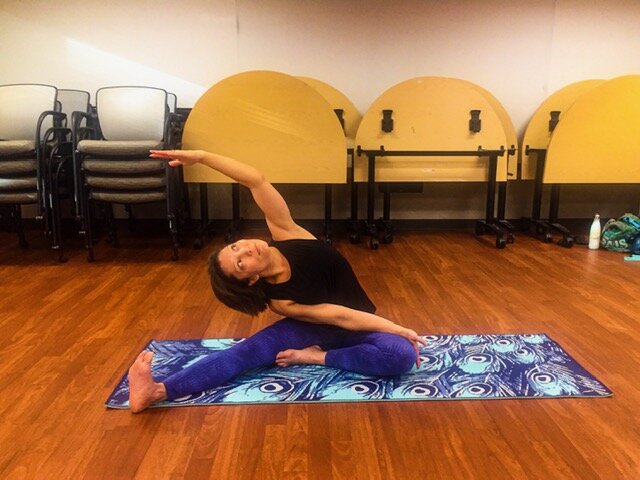Letting Go of the "Full Expression of the Pose" - In Yoga and Life
/Pavritta Konasa - I have no delusions of being able to grab my foot with my top hand, and that’s completely OK. This is my “full expression” of the pose at the moment.
In yoga, you’ll often hear the phrase “full expression of the pose”. It’s a phrase that I’ve both caught myself saying, probably because I’ve heard it so often that it sometimes slips out, and also a phrase I don’t love and try to correct when I accidentally say it. The “full expression” basically means “how the pose looks if every arm/leg/foot/hand/body part” is where yoga guidelines, or at least that particular yoga type, indicates it would be. (Very rough translation of the phrase, by the way). And I get that there have to be some guidelines that indicate what a pose ideally looks like, as it gives a starting point, helps us to work into proper alignment, and provides us with an image of what we’re generally trying to make our bodies do. Without this, it would virtually be a game of Simon says, telling people where to put this arm and that leg, which obviously is not what we’re aiming for in teaching yoga. But we also talk often in yoga about meeting yourself where you are. About there being no right way to be a yogi, about it being a process, about it being for everybody and every BODY. So I don’t love the idea of saying “be fine with wherever you are right now” and then following it up with “and here’s how it should ideally look”. (Note: obviously if someone is doing something unsafe, that’s a different story, as safety has to be a priority).
So with October’s theme of letting go, I’m inviting you to let go of this idea of the “full expression of the pose” as we’ve traditionally used it in yoga. Instead of thinking of the full expression of the pose as this ideal version of a pose where everything is perfectly aligned, what if we think of it as “OUR full expression of the pose” at this moment. Like for me, right now my full expression of Pavritta Konasana (revolved wide legged forward bend) pictured above, does not involve my top hand reaching anywhere near my flexed foot. Sure, I could maybe reach closer to my foot if I contorted my body and focused on hand to foot at all costs, but it would involve me crunching my ribs/belly/everything else, instead of opening up the chest and side body. I’d be missing the intention of the pose, the reason we do this particular asana in the first place. So, at least for the time being, the version pictured above is my full expression of the pose. And in fact, if I allow the “full expression as it is to me” to be a bit of a fluid or moving target, it helps keep me more motivated to continue to work in the pose. Instead of trying to get to some ideal, I’m working on small adjustments in my body that, over time, might help me feel more comfortable in the pose and adjust as needed to my body and what serves me best on any given day. It allows me to truly meet myself where I am, instead of “meeting myself where I am but really aiming for xyz.”
And we don’t just do this in yoga; we do it in life. A perfect example is the novel I published this past summer. It’s my first novel, and I’m incredibly proud. Still, at first, whenever anyone said something like “Wow you published a novel!” I would reply with a joke like, “Well, I mean, it’s self-published, so, not like they could turn me down really….”. Basically, I concluded that I wasn’t the “fullest expression of a published author” because of the publishing route I’d taken. And in doing so, it dismissed all the work and creativity and effort I put into it. It dismissed the fact that I have a novel on Amazon and Barnes & Noble, that I have a paperback with my name on it that I can hold in my hands, that numerous friends and family ordered and read and enjoyed, simply because I didn’t view it as the “fullest expression” of being the author of a published novel. But several months into having my book out in the world, I’ve let go of this idea. Now, when people ask me who my publisher is, I give the name of the company I used to self-publish. If they ask further details, I tell them about it, and I’m happy to tell them it’s a self-publishing company, not because I’m diminishing my accomplishment, but because I am a big supporter of both the company and the self-publishing industry, because I’m proud of what I’ve accomplished. I want to share with others that it’s not one size fits all, that there’s not one “fullest expression” of being a published author, and to perhaps encourage them, if they’re thinking about publishing their work, to consider all “expressions of the pose”, as it were.
And so, whether it's an actual yoga pose, or an area in your life where you diminish your accomplishments because you feel it doesn’t meet the ideal criteria, I encourage you to let go of that “fullest expression of the pose”. I encourage you, instead, to focus on what feels good about what you’re doing, where you feel accomplished in it. And of course it’s great to have goals that you work towards, both in yoga and in life. But they should be goals that you want to work towards because you want to work towards them - not because someone else has decided that it’s the ideal point for you to get to, or that you’re not “fully there” if you don’t meet those expectations.






